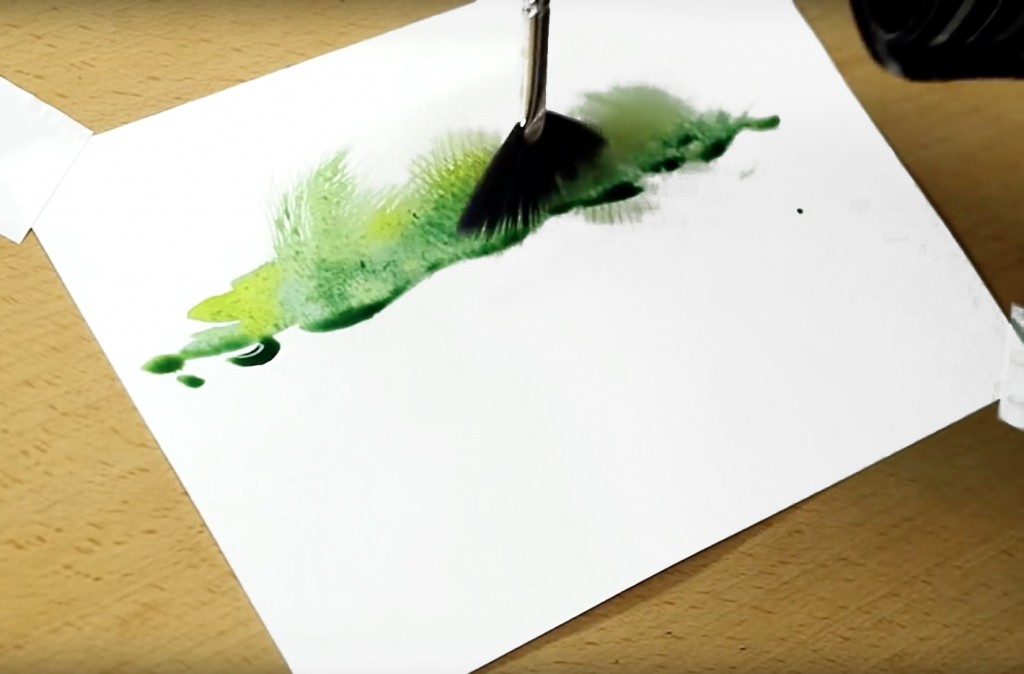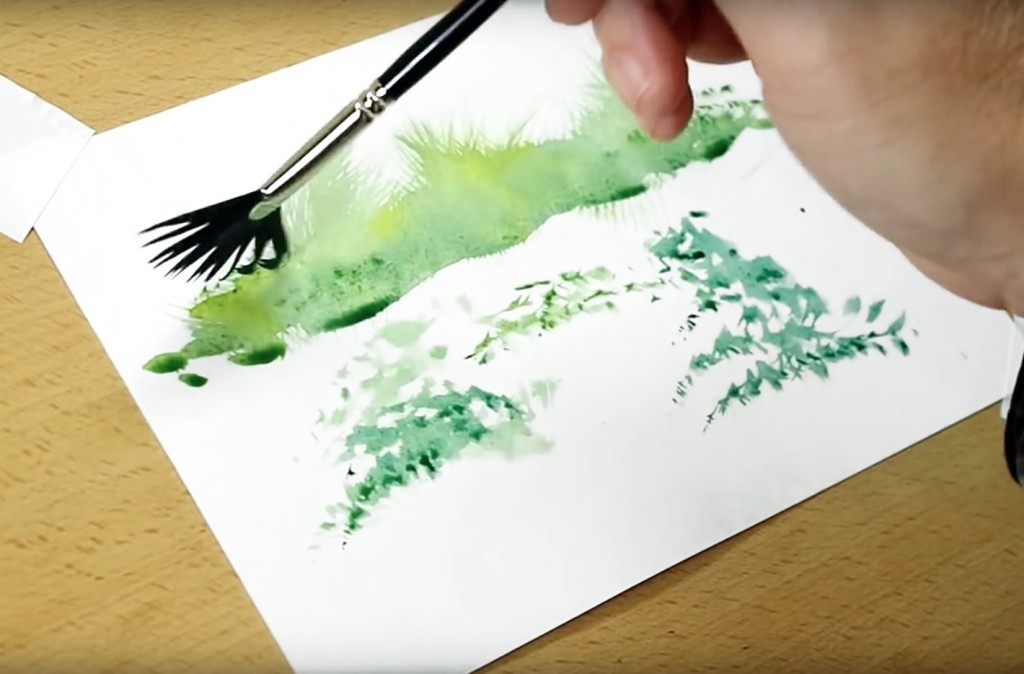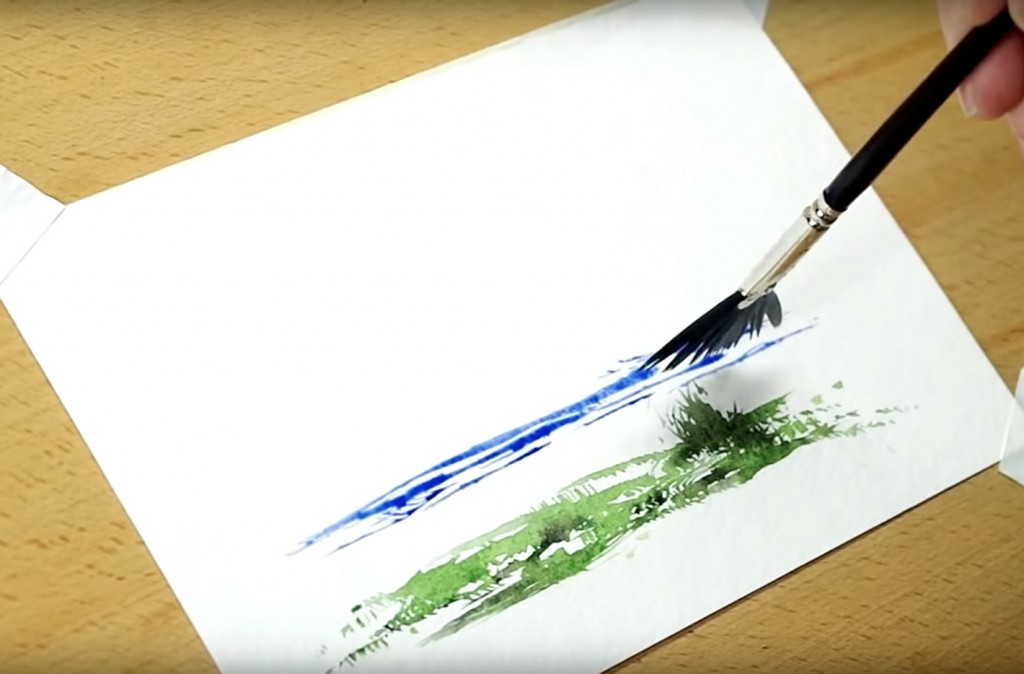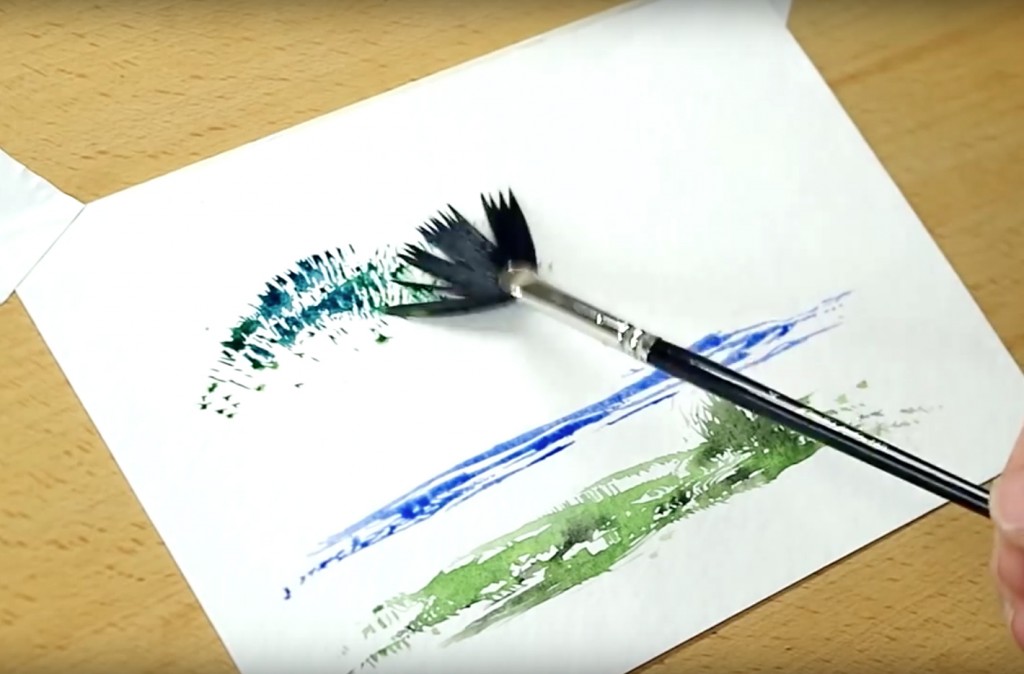Have a fan brush but have no idea how to use it? Here are 4 watercolor techniques using a fan brush, courtesy of Steve Mitchell. Thanks Steve!
Materials used:
- A few small sheets of watercolor paper
- Masking tape (width 1")
- Painting palette for watercolor paints
- Your choice of watercolor paints
- A container of water
- A towel or rag to dry off the brushes
- Fan brush (size 4 and size 10/0)
- Round brush (size 8)
Random Upward Strokes
 Tape a small sheet of watercolor paper to your workspace or a wooden board for support (you can switch papers whenever you run out of space). Then, using the round brush, mix some water into your green paint before painting a saturated line onto the paper. While the paint is still wet, take the clean size 4 fan brush and gently brush in an upwards motion, starting from the bottom of the line of green and ending above the initial line. Gradually lift the brush off the paper to taper the points. You can curve the lines to the left and right to create a grassy effect. You can also use a twisting motion, or use the edge of the bristles to prevent the grass from looking too patterned (i.e. regular).
Tape a small sheet of watercolor paper to your workspace or a wooden board for support (you can switch papers whenever you run out of space). Then, using the round brush, mix some water into your green paint before painting a saturated line onto the paper. While the paint is still wet, take the clean size 4 fan brush and gently brush in an upwards motion, starting from the bottom of the line of green and ending above the initial line. Gradually lift the brush off the paper to taper the points. You can curve the lines to the left and right to create a grassy effect. You can also use a twisting motion, or use the edge of the bristles to prevent the grass from looking too patterned (i.e. regular).
Side Crunch
 The next technique was taken from oil painter Bob Ross, and can be used for oil painting as well. Steve calls this technique the "side crunch", where you hold the fan brush perpendicular to the paper and "crunch" the bristles onto the paper. Move the brush up and down in a stabbing motion, and work your way back and forth to create a dotted texture. The resulting effect should look like spiky leaves on a tree.
The next technique was taken from oil painter Bob Ross, and can be used for oil painting as well. Steve calls this technique the "side crunch", where you hold the fan brush perpendicular to the paper and "crunch" the bristles onto the paper. Move the brush up and down in a stabbing motion, and work your way back and forth to create a dotted texture. The resulting effect should look like spiky leaves on a tree.
Side To Side
 Another method is to hold the fan brush so it's horizontal to the paper, then use the edge to paint side-to-side. Don't paint completely straight lines; rather, you can let the brush move down a little occasionally to create a mossy or grass-like texture (called "scumbling"). For more controlled strokes, use the corner of the brush. Another way to use this technique is to paint water ripples with some blue paint. As mentioned before, you can scumble the edges to create a more irregular effect.
Another method is to hold the fan brush so it's horizontal to the paper, then use the edge to paint side-to-side. Don't paint completely straight lines; rather, you can let the brush move down a little occasionally to create a mossy or grass-like texture (called "scumbling"). For more controlled strokes, use the corner of the brush. Another way to use this technique is to paint water ripples with some blue paint. As mentioned before, you can scumble the edges to create a more irregular effect.
Bouncing
 The most unusual technique is the bouncing technique. This is where you hold the end of the fan brush between your thumb and forefinger, then lightly bounce the brush on the paper. This creates a dot-like texture, although Steve doesn't really recommend using this technique to paint foliage as it is again too regular-looking. You can bounce the brush on its edge to vary the effect and prevent the dots from looking too patterned. Feel free to experiment for yourself! You'll discover which techniques you're most comfortable with, and practice your fine-motor skills at the same time. Here's a video of Steve demonstrating each technique:
The most unusual technique is the bouncing technique. This is where you hold the end of the fan brush between your thumb and forefinger, then lightly bounce the brush on the paper. This creates a dot-like texture, although Steve doesn't really recommend using this technique to paint foliage as it is again too regular-looking. You can bounce the brush on its edge to vary the effect and prevent the dots from looking too patterned. Feel free to experiment for yourself! You'll discover which techniques you're most comfortable with, and practice your fine-motor skills at the same time. Here's a video of Steve demonstrating each technique:



